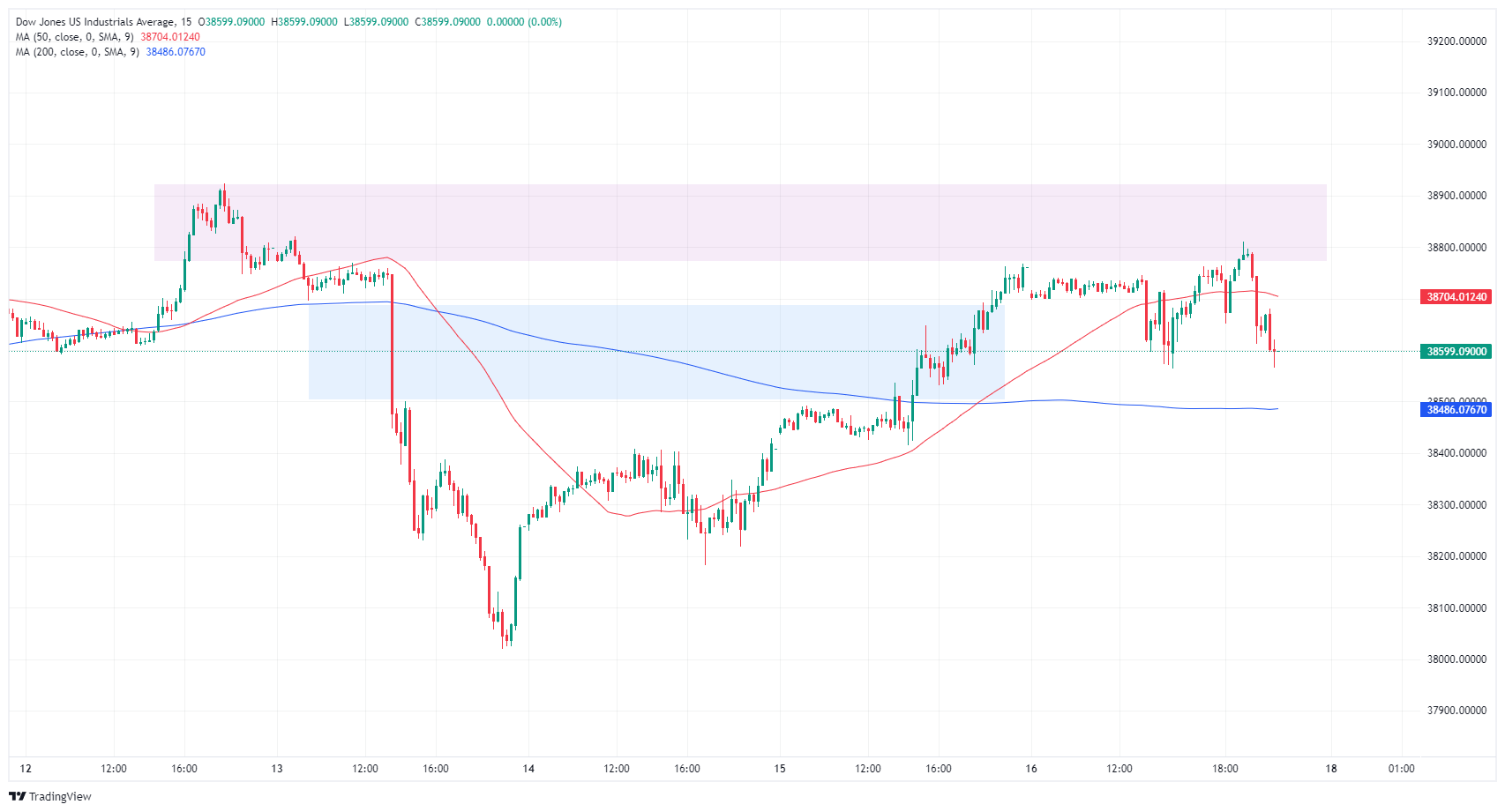- Wall Street’s main indexes trade mixed after opening marginally lower on Friday.
- Producer inflation data from the US came in stronger than forecast.
- Communication Services Sector is the worst-performing major S&P 500 sector midday.
The S&P 500 (SPX) index fell 0.48% to close the session at 5,005.57. The Dow Jones (DJIA) dropped 0.37% to end at 38,627.99, while the Nasdaq (IXIC) lost 0.82% to finish at 15,775.65.
Stock market news
- The Communication Services sector ended Friday in the red by 1.56% as the worst-performing major S&P sector, followed by the Real Estate Sector that shed 0.99% by the Friday closing bell. On the flip side, Friday’s largest-gaining sector was the S&P’s Materials Sector, climbing 0.51% on the day.
- Applied Materials Inc. (AMAT) is the top S&P 500 gainer on Friday, rising 6.347% to end the day at $199.57. Digital Realty Trust Inc. (DLR) lost 8.337%, wrapping up Friday’s trading at $136.22 as the biggest decliner.
- The Bureau of Labor Statistics reported on Friday that the Producer Price Index (PPI) for final demand in the US rose 0.9% on a yearly basis in January. This reading followed the 1% increase recorded in December but came in above the market expectation of 0.6%. The annual Core PPI rose 2% in the same period, compared to December’s increase of 1.8%. On a monthly basis, the Core PPI was up 0.5% following the 0.1% decline recorded in the previous month.
- The University of Michigan’s Consumer Sentiment Index improved modestly to 79.6 in February’s flash estimate from 79.0 in January. The Current Conditions Index edged lower to 81.5 from 81.9 and the Consumer Expectations Index rose to 78.4 from 77.1.
- The CBOE Volatility Index (VIX), Wall Street’s fear gauge, is down 1%.
- Retail Sales in the US declined by 0.8% to $700.3 billion in January, the US Census Bureau reported on Thursday. This reading came in weaker than the market expectation for a decrease of 0.1%. Retail Sales ex Autos contracted by 0.6% in the same period.
- There were 212,000 first-time applications for unemployment benefits in the week ending February 10, down from 220,000 in the previous week, the US Department of Labor announced.
- Inflation in the US, as measured by the change in the Consumer Price Index (CPI), softened to 3.1% on a yearly basis in January from 3.4% in December, the BLS reported on Tuesday. This reading came in above the market expectation of 2.9%.
- The Core CPI, which excludes volatile food and energy prices, rose 3.9% in the same period and matched December’s increase, surpassing analysts’ estimate of 3.7%.
- Coinbase Global Inc. (COIN) reported after the closing bell on Thursday earnings of $1.04/share in the fourth quarter, compared to a loss of $2.46/share a year earlier. The company noted sturdy trading volumes due to a resurgence of interest in crypto was the primary reason for the first quarterly profit it recorded since 2021.
- On Tuesday, Coca-Cola Co. (KO) reported that revenue rose 7.4% to $10.95 billion from a year ago for the quarter ended in December, per Reuters. The company announced that the quarterly net income was $1.97 billion for that period and cited higher product prices and robust demand for the upbeat results.
- Airbnb Inc. (ABNB) said after the closing bell on Tuesday that quarterly adjusted earnings were 76 cents per share in the quarter ended in December. The company’s revenue increased 16.6% to $2.22 billion from a year ago, but there was a quarterly loss of $349 million.
- Cisco Systems Inc. (CSCO) announced quarterly adjusted earnings per share were 87 cents in the quarter ended in January. The networking equipment manufacturer said the revenue fell 5.9% to $12.79 billion from a year ago, while the quarterly net income was $2.63 billion in the same period. In a conference call, CEO Charles Robbins said, “we also continue to see weak demand with our telco and cable service provider customers,” per Reuters. The company is reportedly planning to cut more than 4,000 jobs and focus on high-growth areas such as artificial intelligence and software.
Dow Jones 15-minute chart
Dow Jones FAQs
The Dow Jones Industrial Average, one of the oldest stock market indices in the world, is compiled of the 30 most traded stocks in the US. The index is price-weighted rather than weighted by capitalization. It is calculated by summing the prices of the constituent stocks and dividing them by a factor, currently 0.152. The index was founded by Charles Dow, who also founded the Wall Street Journal. In later years it has been criticized for not being broadly representative enough because it only tracks 30 conglomerates, unlike broader indices such as the S&P 500.
Many different factors drive the Dow Jones Industrial Average (DJIA). The aggregate performance of the component companies revealed in quarterly company earnings reports is the main one. US and global macroeconomic data also contributes as it impacts on investor sentiment. The level of interest rates, set by the Federal Reserve (Fed), also influences the DJIA as it affects the cost of credit, on which many corporations are heavily reliant. Therefore, inflation can be a major driver as well as other metrics which impact the Fed decisions.
Dow Theory is a method for identifying the primary trend of the stock market developed by Charles Dow. A key step is to compare the direction of the Dow Jones Industrial Average (DJIA) and the Dow Jones Transportation Average (DJTA) and only follow trends where both are moving in the same direction. Volume is a confirmatory criteria. The theory uses elements of peak and trough analysis. Dow’s theory posits three trend phases: accumulation, when smart money starts buying or selling; public participation, when the wider public joins in; and distribution, when the smart money exits.
There are a number of ways to trade the DJIA. One is to use ETFs which allow investors to trade the DJIA as a single security, rather than having to buy shares in all 30 constituent companies. A leading example is the SPDR Dow Jones Industrial Average ETF (DIA). DJIA futures contracts enable traders to speculate on the future value of the index and Options provide the right, but not the obligation, to buy or sell the index at a predetermined price in the future. Mutual funds enable investors to buy a share of a diversified portfolio of DJIA stocks thus providing exposure to the overall index.
